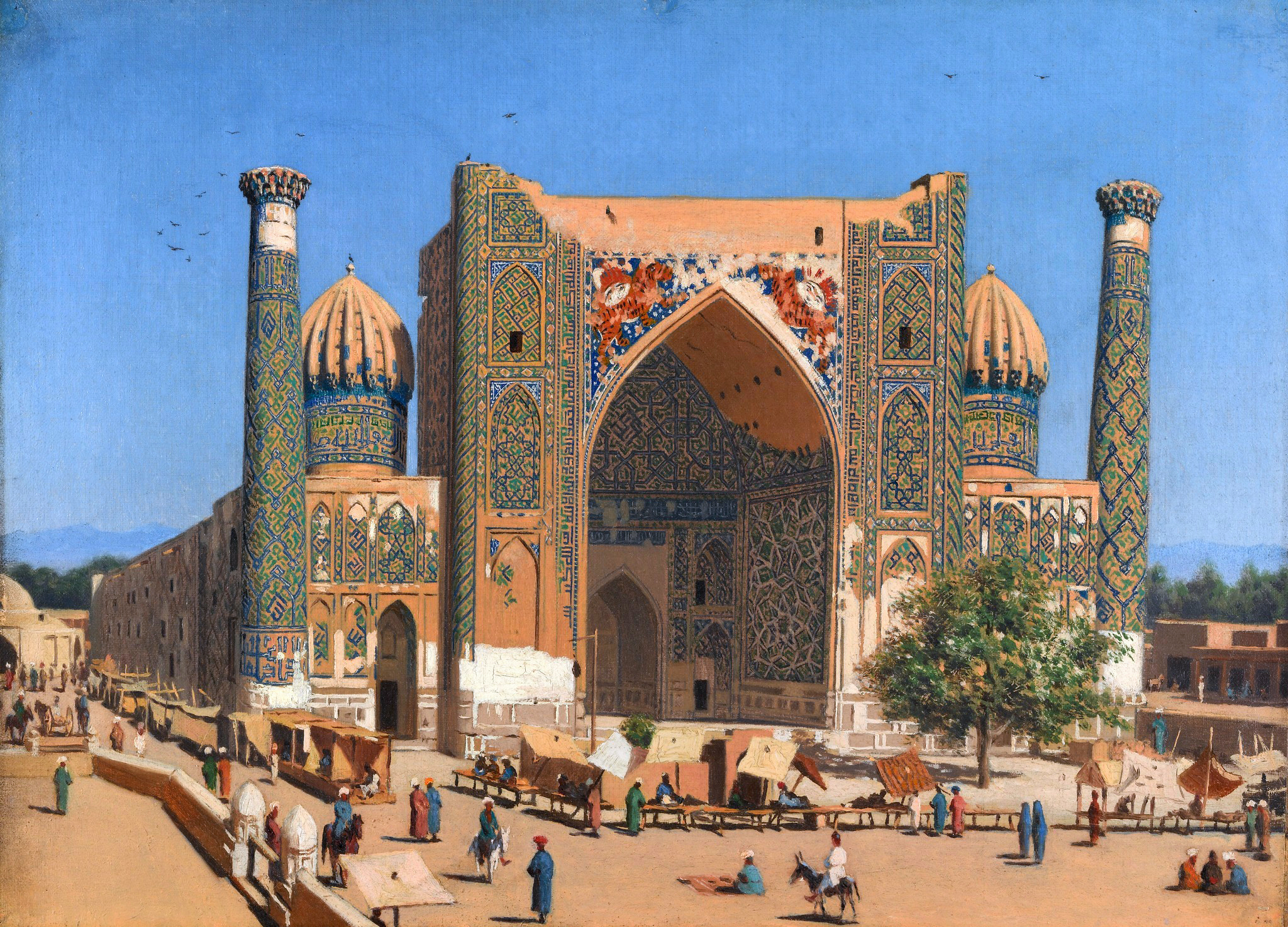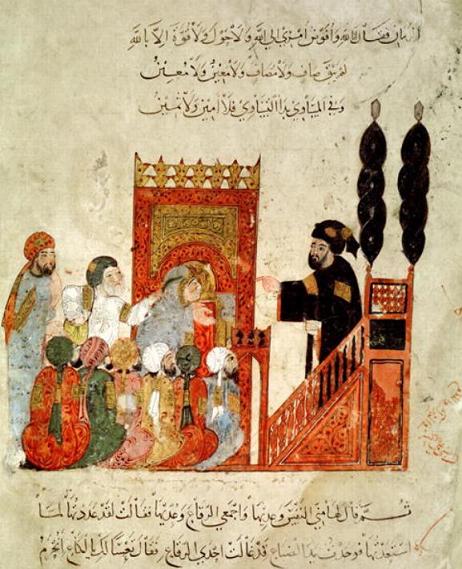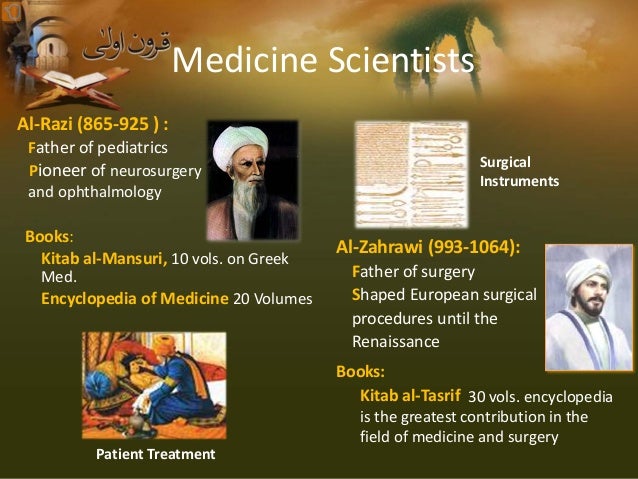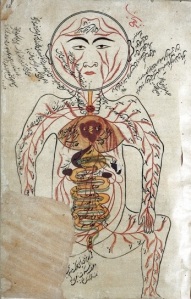Education and Scientific Learning
Centers of Learning:

Mosques
increased in number under the caliphs, Some mosques, such as that of al-Mansur,
built during the reign of Harun ar-Rashid in Baghdad, or those in Isfahan,
Mashhad, Ghom, Damascus, Cairo, and the Alhambra (Granada-Spain), became
centres of learning for students from all over the Muslim world. Each mosque
usually contained several study circles (Halqah), so named because the teacher
was, as a rule, seated on a dais or cushion with the pupils gathered in a
semicircle before him.
Elementary
schools (maktab, or kuttab), in which pupils learned to read and
write, were developed into centres for instruction in elementary Islamic
subjects. Students were expected to memorize the Qur’an as perfectly as
possible. Some schools also included in their curriculum the study of poetry,
elementary arithmetic, physical sciences, penmanship, ethics (manners), and
elementary grammar. Maktabs were quite common in almost every town or village
in the Middle East , Asia ,
Africa , Sicily Spain
Institutions
and Universities:
Madrasahs
existed as early as the 9th century, but the most famous one was founded in
1057 by the vizier Nizam al-Mulk in Baghdad Cordoba Seville Toledo Granada ,
Murcia Almería , Valencia

Later
the philosophy, medicine and sciences were added to the curriculum. Gradually
these subjects got eliminated after having reached climax resulting in decline.
In the 19th century philosophy was reinstated. The modernization have resulted
in the addition of social sciences at its new supplementary campus. Presently a
number of Islamic Universities have been established in the Muslim countries
where apart from theology, the other sciences are also taught, but they are few
in numbers. There are thousands of traditional madrasah and Dar-ul-Aloom in
countries with Muslim populations where only Islamic theology and religious
sciences are taught, producing millions of ulema (religious scholars) with
almost no knowledge of social, physical sciences and other branches of
knowledge.


Early Muslim Education:
Early
Muslim education emphasized practical studies, such as the application of
technological expertise to the development of irrigation systems, architectural
innovations, textiles, iron and steel products, earthenware, and leather
products; the manufacture of paper and gunpowder; the advancement of commerce;
and the maintenance of a merchant marine. After the 11th century, however,
denominational interests dominated higher learning, and the Islamic sciences
achieved preeminence. Greek knowledge was studied in private, if at all, and
the literary arts diminished in significance as educational policies
encouraging academic freedom and new learning were replaced by a closed system
characterized by an intolerance toward scientific innovations, secular
subjects, and creative scholarship. This denominational system spread
throughout eastern Islam between about 1050 and 1250 C.E.
Pursuit
of Scientific Knowledge & Libraries:
Thus
during first half of millennia of its history, Islamic civilization has been
keen to gain knowledge, be it physics, chemistry (alchemi), algebra,
mathematics, astronomy, medicine, social sciences, philosophy or any other
field. The high degree of learning and scholarship in Islam, particularly
during the 'Abbasid period in the East and the later Umayyads in West (Spain Damascus Baghdad Cordoba
Islam in Renaissance
& Enlightenment:

Stages of
Evolution of Learning Process:
The education
and learning process may be divided in to various stages among the Muslims. The
renaissance of Islamic culture and scholarship developed largely under the
'Abbasid administration in Eastern side and under the later Umayyads in the
West, mainly in Spain
Muslim
Contributions in Medicine, Science & Technology:

The
contributions in the advancement of knowledge by the traditional Islamic
institutions of learning (Madrasahs, Maktab, Halqa & Dar-ul-Aloom) are
enormous, which have been summed up in Encyclopedia Britannica: “The madrasahs generally offered instruction
in both the religious sciences and other branches of knowledge. The
contribution of these institutions to the advancement of knowledge was vast.


Muslim
scholars calculated the angle of the ecliptic; measured the size of the Earth;
calculated the precession of the equinoxes; explained, in the field of optics
and physics, such phenomena as refraction of light, gravity, capillary
attraction, and twilight; and developed observatories for the empirical study
of heavenly bodies. They made advances in the uses of drugs, herbs, and foods for
medication; established hospitals with a system of interns and externs;
discovered causes of certain diseases and developed correct diagnoses of them;
proposed new concepts of hygiene; made use of anesthetics in surgery with newly
innovated surgical tools; and introduced the science of dissection in anatomy.
Muslims
furthered the scientific breeding of horses and cattle; found new ways of
grafting to produce new types of flowers and fruits; introduced new concepts of
irrigation, fertilization, and soil cultivation; and improved upon the science
of navigation. In the area of chemistry, Muslim scholarship led to the
discovery of such substances as potash, alcohol, nitrate of silver, nitric
acid, sulfuric acid, and mercury chloride.
Muslims
scientists also developed to a high degree of perfection the arts of textiles,
ceramics, and metallurgy.” According to a US study published by the American
Association for the Advancement of Science in its Journal on 21 February
2007; ‘Designs on surface tiles in the
Islamic world during the Middle Ages revealed their maker’s understanding of
mathematical concepts not grasped in the West until 500 years later. Many
Medieval Islamic buildings walls have ornate geometric star and polygon or
‘girih’, patterns, which are often overlaid with a swirling network of lines -
This girih tile method was more efficient and precise than the previous
approach, allowing for an important breakthrough in Islamic mathematics and
design.’
Muslims
Scholars of Theology and Science:
According
to the famous scientist Albert Einstein; “Science without religion is lame.
Religion without science is blind.” Francis Bacon, the famous philosopher, has
rightly said that a little knowledge of science makes you an atheist, but an
in-depth study of science makes you a believer in God. A critical analysis
reveals that most of Muslim scientists and scholars of medieval period were
also eminent scholars of Islam and theology. The earlier Muslim scientific
investigations were based on the inherent link between the physical and the
spiritual spheres, but they were informed by a process of careful observation
and reflection that investigated the physical universe.
Influence
of Qur’an on Muslims Scientists:
The
worldview of the Muslims scientists was inspired by the Qur’an and they knew
that: “Surely, In the creation of the heavens and the earth; in the alternation
of the night and the day, in the sailing of the ships through the ocean for the
profit of mankind; in the rain which Allah sends down from the skies, with
which He revives the earth after its death and spreads in it all kinds of
animals, in the change of the winds and the clouds between the sky and the
earth that are made subservient, there are signs for rational
people.”(Qur’an;2:164). “Indeed in the alternation of the night and the day and
what Allah has created in the heavens and the earth, there are signs for those
who are God fearing.”(Qur’an;10:6). They were aware that there was much more to
be discovered. They did not have the precise details of the solar and lunar
orbits but they knew that there was something extremely meaningful behind the
alternation of the day and the night and in the precise moveme
nts of the sun and the moon as mentioned in Qur’an: One can still verify that those who designed the dome and the minaret, knew how to transform space and silence into a chanting remembrance that renews the nexus between God and those who respond to His urgent invitation.

nts of the sun and the moon as mentioned in Qur’an: One can still verify that those who designed the dome and the minaret, knew how to transform space and silence into a chanting remembrance that renews the nexus between God and those who respond to His urgent invitation.

Famous Muslim
Scientists and Scholars:
The
traditional Islamic institutions of learning produced numerous great
theologians, philosophers, scholars and scientists. Their contributions in
various fields of knowledge indicate the level of scholarship base developed
among he Muslims one thousand years ago. Only few are being mentioned here:

Chemistry:
Jabir
ibn Hayyan, Abu Musa (721-815), alchemist known as the "father of
chemistry." He studied most branches of learning, including medicine. After
the 'Abbasids defeated the Umayyads, Jabir became a court physician to the
'Abbasid caliph Harun ar-Rashid. Jabir was a close friend of the sixth Shi'ite
imam, Ja'far ibn Muhammad, whom he gave credit for many of his scientific
ideas.
Mathematics,
Algebra, Astronomy & Geography:
Al-Khwarizmi
(Algorizm) (770–840 C.E) was a researcher of mathematics, algorithm, algebra,
calculus, astronomy & geography. He compiled astronomical tables,
introduced Indian numerals (which became Arabic numerals), formulated the
oldest known trigonometric tables, and prepared a geographic encyclopedia in
cooperation with 69 other scholars.
Physics,
Philosophy, Medicine:

Ibn Ishaq
Al-Kindi (Alkindus) (800–873 C.E) was an intellectual of
philosophy, physics, optics, medicine, mathematics & metallurgy.

Ali Ibn
Rabban Al-Tabari(838–870 C.E) was a scholar in medicine, mathematics,
calligraphy & literature. Al-Razi (Rhazes) (864– 930 C.E), a physical and
scientist of medicine, ophthalmology, smallpox, chemistry & astronomy.
Ar-Razi's two
most significant medical works are the Kitab al-Mansuri, which became well
known in the West in Gerard of Cremona's 12th-century Latin translation; and
‘Kitab al-hawi’, the "Comprehensive Book".
Among
his numerous minor medical treatises is the famed Treatise on the Small Pox and
Measles, which was translated into Latin, Byzantine Greek, and various modern
languages.
Al-Farabi
(Al-Pharabius) (870- 950 C.E) excelled in sociology, logic, philosophy, political
science & music. Abu Al-Qasim Al-Zahravi (Albucasis; 936 -1013 C.E) was an
expert in surgery & medicine known as the father of modern surgery.
Ibn
Al-Haitham (Alhazen) (965-1040 C.E); was the mathematician and
physicist who made the first significant contributions to optical theory since
the time of Ptolemy (flourished 2nd century).
In his
treatise on optics, translated into Latin in 1270 as Opticae thesaurus Alhazeni
libri vii, Alhazen published theories on refraction, reflection, binocular
vision, focusing with lenses, the rainbow, parabolic and spherical mirrors,
spherical aberration, atmospheric refraction, and the apparent increase in size
of planetary bodies near the Earth's horizon. He was first to give an accurate
account of vision, correctly stating that light comes from the object seen to
the eye.
Abu
Raihan Al-Biruni (973-1048 C.E);
was a
Persian scholar and scientist, one of the most learned men of his age and an
outstanding intellectual figure. Al-Biruni's most famous works are Athar
al-baqiyah (Chronology of Ancient Nations); at-Tafhim ("Elements of
Astrology"); al-Qanun al-Mas'udi ("The Mas'udi Canon"), a major
work on astronomy, which he dedicated to Sultan Mas'ud of Ghazna; Ta'rikh
al-Hind ("A History of India"); and Kitab as-Saydalah, a treatise on
drugs used in medicine.

In his works on astronomy, he discussed with approval
the theory of the Earth's rotation on its axis and made accurate calculations
of latitude and longitude. He was the first one to determine the
circumference earth. In the filed of physics, he explained natural springs
by the laws of hydrostatics and determined with remarkable accuracy the
specific weight of 18 precious stones and metals. In his works on geography, he
advanced the daring view that the valley of the Indus
had once been a sea basin.


Ibn
Sina (Avicenna, 981–1037 C.E); was a scientist of medicine,
philosophy, mathematics & astronomy.

He was
particularly noted for his contributions in the fields of Aristotelian philosophy
and medicine. He composed the Kitab ash-shifa` ("Book of Healing"), a
vast philosophical and scientific encyclopedia, and the Canon of Medicine,
which is among the most famous books in the history of medicine.
Ibn
Hazm, (994-1064 C.E) was a Muslim litterateur, historian,
jurist, and theologian of Islamic Spain. One of the leading exponents of the
Zahiri (literalist) school of jurisprudence, he produced some 400 works,
covering jurisprudence, logic, history, ethics, comparative religion, and theology,
and The Ring of the Dove, on the art of love.
Al-Zarqali
(Arzachel) (1028-1087 C.E); an astronomer who invented astrolabe (an instrument
used to make astronomical measurements). Al-Ghazali (Algazel) (1058-1111 C.E);
was a scholar of sociology, theology & philosophy.
Ibn
Zuhr (Avenzoar) (1091-1161 C.E); was a scientist and expert
in surgery & medicine.
Ibn
Rushd (Averroes) (1128- 1198 C.E); excelled in philosophy,
law, medicine, astronomy & theology.
Nasir
Al-Din Al-Tusi (1201-1274 C.E); was the scholar of astronomy and
Non-Euclidean geometry.
Geber
(flourished in 14th century Spain
They
are the clearest expression of alchemical theory and the most important set of
laboratory directions to appear before the 16th century. Accordingly, they were
widely read and extremely influential in a field where mysticism, secrecy, and
obscurity were the usual rule. Geber's rational approach, however, did much to
give alchemy a firm and respectable position in Europe .
His practical directions for laboratory procedures were so clear that it is
obvious he was familiar with many chemical operations. He described the
purification of chemical compounds, the preparation of acids (such as nitric
and sulfuric), and the construction and use of laboratory apparatus, especially
furnaces. Geber's works on chemistry were not equaled in their field until the
16th century with the appearance of the writings of the Italian chemist
Vannoccio Biringuccio, the German mineralogist Georgius Agricola, and the
German alchemist Lazarus Ercker.
Muhammad
Ibn Abdullah (Ibn Battuta) (1304-1369 C.E); was a world traveler, he
traveled 75,000 mile voyage from Morocco China
Tipu,
Sultan of Mysore India London
Turkish
scientist Hazarfen Ahmet Celebi took off from Galata tower and flew over the
Bosphorus, two hundred years before a comparable development elsewhere. Fifty years later Logari Hasan Celebi,
another member of the Celebi family, sent the first manned rocket into upper
atmosphere, using 150 okka (about 300 pounds) of gunpowder as the firing fuel.
Contribution
of Great Muslim Women & Scholars:
Islam
does not restrict acquisition of knowledge to men only, the women are equally
required to gain knowledge. Hence many eminent women have contributed in
different fields. Aishah as-Siddiqah (the one who affirms the Truth), the
favourite wife of Propeht Muhammad (peace be upon him), is regarded as the best
woman in Islam. Her life also substantiates that a woman can be a scholar,
exert influence over men and women and provide them with inspiration and
leadership. Her life is also an evidence of the fact that the same woman can be
totally feminine and be a source of pleasure, joy and comfort to her husband.
The example of Aishah in promoting education and in particular the education of
Muslim women in the laws and teachings of Islam is one which needs to be
followed. She is source of numerous Hadith and has been teaching eminent
scholars. Because of the strength of her personality, she was a leader in every
field in knowledge, in society and in politics.
Sukayna (also
“Sakina), the great granddaughter of the Prophet (peace be upon him), and
daughter of Imam Husain was the most brilliant most accomplished and virtuous
women of her time. She grew up to be an outspoken critic of the Umayyads. She
became a political activist, speaking against all kinds of tyranny and
personal, social and political iniquities and injustice. She was a fiercely
independent woman. She married more than once, and each time she stipulated
assurance of her personal autonomy, and the condition of monogamy on the
prospective husband’s part, in the marriage contract. She went about her
business freely, attended and addressed meetings, received men of letters,
thinkers, and other notables at her home, and debated issues with them. She was
an exceedingly well-educated woman who would take no nonsense from anyone
howsoever high and mighty he or she might be.
Um
Adhah al-Adawiyyah (d. 83 AH), reputable scholar and narrator of Hadith
based on reports of Ali ibn Abu Talib and Ayesha; Amrah bint Abd al-Rahman (d.
98 AH), one of the more prominent students of Ayesha and a known legal scholar
in Madina whose opinions overrode those of other jurists of the time; Hafsa
bint Sirin al-Ansariyyah (d. approx. 100 AH), also a legal scholar. Amah
al-Wahid (d. 377 AH), noted jurist of the Shafaii school and a mufti in Baghdad Baghdad Damascus Morocco noon prayer (Zuhr) and women after
the afternoon prayer (Asr). A Muslim woman of the name of Rusa wrote a textbook
on medicine, and another, Ujliyyah bint al-Ijli (d. 944 CE) made instruments to
be used by astronomers. During the Mamluk period in Cairo
Rabi’a
al-Adawiyya al-Basri (717 C.E), is honored as one of the earliest and greatest
sufis in Islam. Orphaned as a child, she was captured and sold into slavery.
But later her master let her go. She retreated into the desert and gave herself
to a life of worship and contemplation. She did not marry, and to a man who
wanted her hand she said: “I have become naught to self and exist only through
Him. I belong wholly to Him. You must ask my hand of Him, not of me.” She
preached unselfish love of God, meaning that one must love Him for His own sake
and not out of fear or hope of rewards. She had many disciples, both men and women.
Zubaida
(Amatal Aziz bint Jafar), the favourite wife of
Harun al-Rashid, the legendary Abassid caliph. She came to be an
exceedingly wealthy woman, a billionaire so to speak, independently of her
husband. Granddaughter of Al-Mansur, she grew up to be a lady of dazzling
beauty, articulate and charming of speech, and great courage. Discerning and
sharp, her wisdom and insightfulness inspired immediate admiration and respect.
In her middle years she moved out of the royal “harem” and began living in a huge
palace of her own. She owned properties all over the empire which dozens of
agents in her employ managed for her. A cultivated woman, pious and well
acquainted with the scriptures, Zubaida was also a poetess and a patron of the
arts and sciences. She allocated funds to invite hundreds of men of letters,
scientists, and thinkers from all over the empire to locate and work in Baghdad
Arwa
bint Ahmad bin Mohammad al-Sulayhi (born 1048 C.E) was the ruling
queen of Yemen for 70 years (1067-1138 C.E), briefly, and that only
technically, as a co-ruler with her two husbands, but as the sole ruler for
most of that time. She is still remembered with a great deal of affection in Yemen Cairo India Gujarat
which still thrives. She was also a competent military strategist. At one point
(1119 C.E) the Fatimid caliph sent a general, Najib ad-Dowla, to take over Yemen Egypt India
Influence
of Islamic Learning in Reviving Western Civilization:
While
Muslims were excelling in the field of knowledge and learning of science and
technology, the conditions of Christendom at this period was deplorable. Under Constantine Greece Rome Europe with its worship of relics and
the remains of saints. Science and literature were placed under the ban by
orthodox Christianity and they succeeded in emancipating themselves only when
Free Thought had broken down the barriers raised by orthodoxy against the
progress of the human mind.
Phenomenal
influence of Islamic learning on the West:
The influence
of Islamic learning on the West has been phenomenal; an extract from
Encyclopedia Britannica is an eye opener for the Muslims:
“The decline of Muslim scholarship
coincided with the early phases of the European intellectual awakening that
these translations were partly instrumental in bringing about. The translation into Latin of most Islamic
works during the 12th and 13th centuries had a great impact upon the European
Renaissance. As Islam was declining in scholarship and Europe
was absorbing the fruits of Islam's centuries of creative productivity, signs
of Latin Christian awakening were evident throughout the European continent.
The 12th century was one of intensified traffic of Muslim learning into the
Western world through many hundreds of translations of Muslim works, which
helped Europe seize the initiative from Islam
when political conditions in Islam brought about a decline in Muslim
scholarship. By 1300 C.E when all that was worthwhile in Muslim scientific,
philosophical, and social learning had been transmitted to European schoolmen
through Latin translations, European scholars stood once again on the solid
ground of Hellenistic thought, enriched or modified through Muslim and
Byzantine efforts.”
“Most of the important Greek scientific
texts were preserved in Arabic translations. Although the Muslims did not alter
the foundations of Greek science, they made several important contributions
within its general framework. When interest in Greek learning revived in
western Europe during the 12th and 13th centuries, scholars turned to Islamic
Spain for the scientific texts. A spate of translations resulted in the revival
of Greek science in the West and coincided with the rise of the universities.
Working within a predominantly Greek framework, scientists of the late Middle
Ages reached high levels of sophistication and prepared the ground for the
scientific revolution of the 16th and 17th centuries.” According to Will
Durant, the Western scholar, “For five centuries , from 700 to 1200 (C.E),
Islam led the world in power, order and extent of government, in refinement of
manners, scholarship and philosophy”.
Related:
Related: